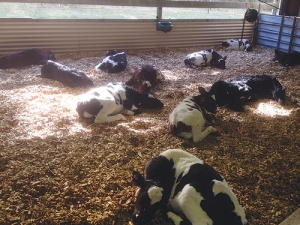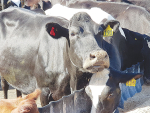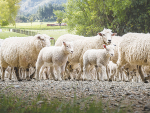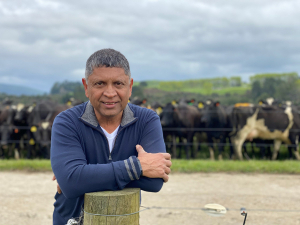Dehorning is considered a routine procedure for dairy calves.
Removing horns from cattle improves animal welfare in the long term by reducing risk of bruising and hide damage, especially during yarding and transport.
Dehorned cattle are safer to handle and they require less trough space than horned cattle. Dehorning also increases the value of the animal and reduces aggressive behaviour in the herd.
The gene responsible for ‘polled’ is actually dominant and the gene responsible for ‘horn growth’ is recessive. Basically this means the dominant ‘polled’ gene can overrule the recessive ‘horn growth’ gene, resulting in the animal being polled.
In the beef industry, genetic selection of known polled animals or animals carrying the ‘polled’ gene has resulted in nearly half of the national beef herd being polled.
However, transitioning to a polled herd is slow and can take several generations for observable results.
Unfortunately, in the dairy industry the ‘horn growth’ gene is predominant and this constrains the opportunity for genetic selection for polled cattle. Most dairy cattle have horns and currently there is no affordable test to detect the ‘polled’ gene in the dairy breeds. Therefore the removal of horns in dairy breeds is likely to continue in the foreseeable future.
Calves are born with horn ‘buds’ and the correct term for removal of these is ‘disbudding’. This can be done using a heated disbudding iron. At eight weeks of age the buds have grown sufficiently and have started to fuse with the underlying bone.
Removal of horns after eight weeks of age is called ‘dehorning’. Due to the fusion of the horn tissue with the skull, horns can only be removed by amputation after eight weeks of age. This can be done with scoop dehorners of varying designs or embryotome wire for larger horns.
Thus, it is desirable to remove horn buds prior to eight weeks of age as the procedure is quicker and less painful.
Hot iron cautery has been shown to be the preferred method of disbudding. However, regardless of method, there is an acute pain response following the procedure which peaks at 30 minutes and can last for eight hours.
Many studies have measured the effect of dehorning on calves and they have repeatedly shown this pattern of pain and stress response.
As a result, the disbudding and dehorning of calves in this way is a welfare concern.
Increased social awareness of the livestock industry could result in routine procedures, such as dehorning, being negatively perceived. In turn, this could impact consumer demand for dairy products.
Advances in veterinary medicine and pharmacology over the past decades have allowed drugs such as sedatives, local anaesthetics and analgesics (pain relief) to become readily available for farm animals. Many of these drugs have been used for years to treat sick or injured animals and to enable surgical procedures to be done. Routine use of these drugs for the purpose of dehorning dairy calves has been embraced in the UK, New Zealand, USA, Sweden, Canada and Denmark.
Regulation and legislation vary internationally but there has been a general acceptance that disbudding and dehorning without local anaesthetic is unethical and unnecessary.
Studies have shown that the best way to reduce the pain and stress associated with this procedure is using a combination of sedation, local anaesthesia to the area surrounding the horn bud and pain relief at the time of the procedure.
Research has demonstrated that the stress/pain response in calves with this combination treatment at disbudding was virtually nil compared to calves disbudded without the combination treatment.
Improved growth rates have been observed in heifers given pain relief at dehorning, compared to heifers that did not receive pain relief. Further research is required to observe the long term effects of a painful event on production.
In Australia, the biggest obstacles to adopting this multimodal approach to disbudding and dehorning are cost and availability of operators qualified to do this work. Specific training on the use of sedatives and knowledge of the anatomy to perform local anaesthesia is required. Cost per calf will vary by region and operator.
These obstacles should not stand in the way of improved welfare for dairy calves. Ultimately consumer awareness puts pressure on the suppliers, who in turn can influence the dairy industry’s code of practice.
The dairy industry needs to adopt routine procedures such as disbudding/dehorning, to avert negative public perception of these procedures. This is 2015; how can putting a hot iron onto a calf’s head without anaesthesia be OK?
• Dr Gemma Chuck is a dairy vet working at The Vet Group in south west Victoria. She has a special interest in calf rearing and is working on a PhD in this at The University of Melbourne.


















